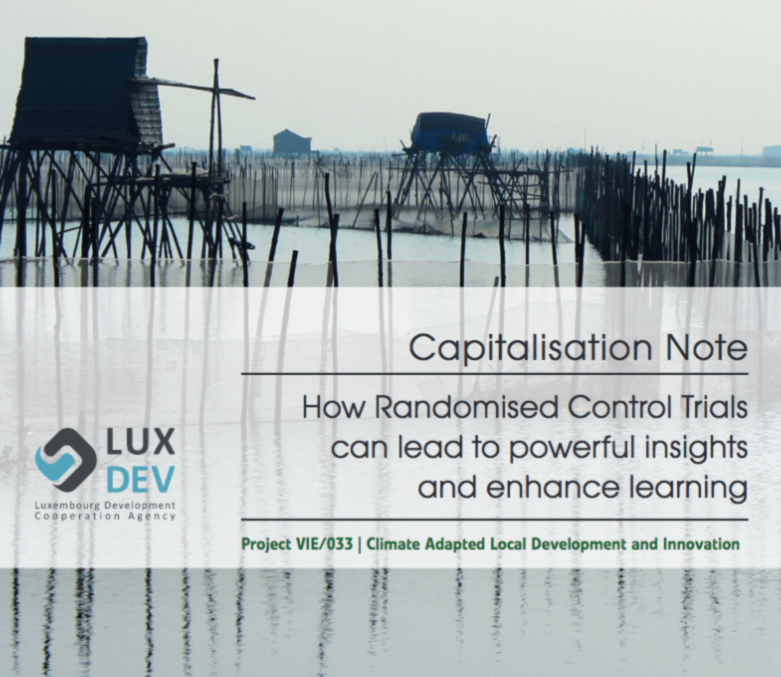Information
Ce projet est clôturé depuis le 30.06.2018.
- Pays
- Vietnam
- Bureau régional de LuxDev
- Bureau Asie
- Agence d'exécution partenaire
- Thua Thien Hue Provincial People’s Committee
- PIC 3
- 2011 - 2015
- Période d'exécution
- 1 Juillet 2013 - 30 Juin 2018
- Durée totale
- 60 mois
- Budget total
- 10 000 000 EUR
- Répartition des contributions
-
- Gouvernement luxembourgeois
8 000 000 EUR - Thua Thien Hue (TTH) province
2 000 000 EUR
Notes de capitalisation
Documentation
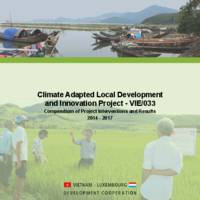
Climate Adapted Local Development and Innovation Project - VIE/033 Compendium of Project Interventions and Results_thumb.jpeg)
Project Fact Sheet
Évaluation intermédiaire
Évaluation finale
References externes
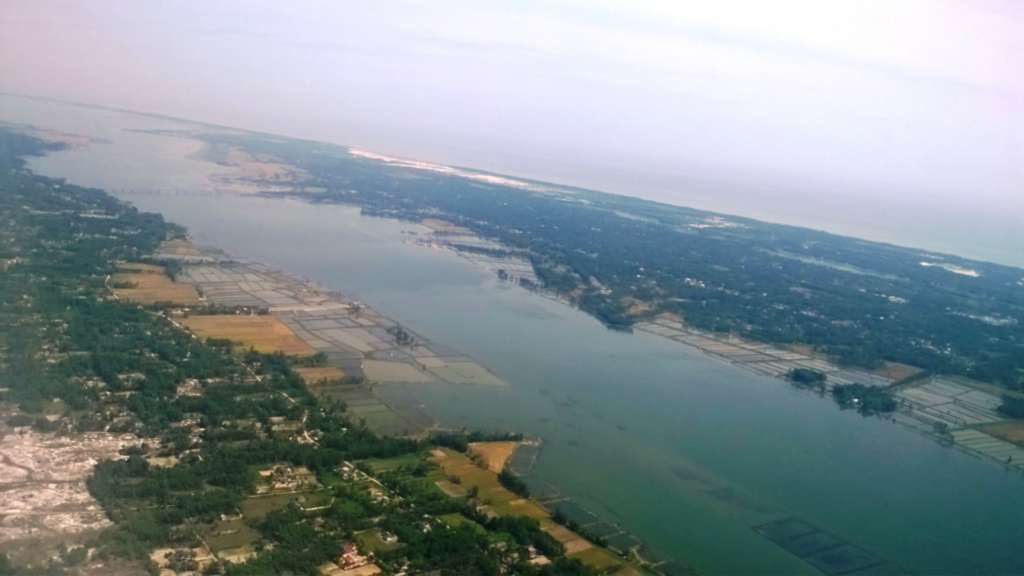
Le projet de Développement local et adapation au changement climatique dans la province de Hué (CALDIP, VIE/033) est bâti sur les succès du projet VIE/023 Quang Dien (2007-2012), qui fût le premier projet en province de Thua Thien Hué mis en œuvre conformément à la Déclaration de Hanoï et le décret gouvernemental 131.
CALDIP intervient dans 29 communes avec des populations pauvres et vulnérables (en région côtière, le lagon et les plaines) des trois districts de la province TT Hué. Les 400 000 bénéficiaires du projet vivent sur 124 000 ha de terres et 22 000 ha de superficie du lagon. Le projet vise spécifiquement les 47 % de pauvres et vulnérables - dont 70 % sont des femmes et 30 % d'anciens "boat people", qui, pour des raisons de sécurité ont été relocalisés sur la terre ferme.
Le projet de développement local et adapation au changement climatique vise à renforcer, adapter et protéger les moyens de subsistance et les biens des gens par rapport aux diverses manifestations du changement climatique - tels que les typhons plus fréquentes et plus forts, de graves inondations dans la saison des pluies, la sécheresse dans la saison sèche, des dommages aux ressources naturelles et de l'écosystème ainsi que l'érosion dramatique des dunes et la perte de terres à l'océan. Ces manifestations très visibles du changement climatique ont déjà un impact majeur sur les activités et la vie économique des populations, et devraient augmenter de façon exponentielle au fil du temps.
En réponse aux défis croissants, et en partenariat avec les gouvernements locaux et la société civile, le projet a identifié 10 grands domaines d'intervention et 34 types d'intervention différents, visant à contribuer à trois résultats attendus :
- amélioration des connaissances, gestion des communautés et leur gouvernance, des systèmes pour le développement socio-économique, l'adaptation et la réduction de la pauvreté ;
- renforcement de la protection, la disponibilité, la résilience et l'utilisation durable des ressources naturelles ;
- promulgation d’activités économiques et commerciales plus diversifiées et axées sur le marché.
Le projet mets un accent particulier sur la participation locale, qui permet aux ménages d'être plus créatifs et autonomes en fonction de leurs aspirations, capacités et leurs ressources.
Dernières nouvelles
Let's share knowledge
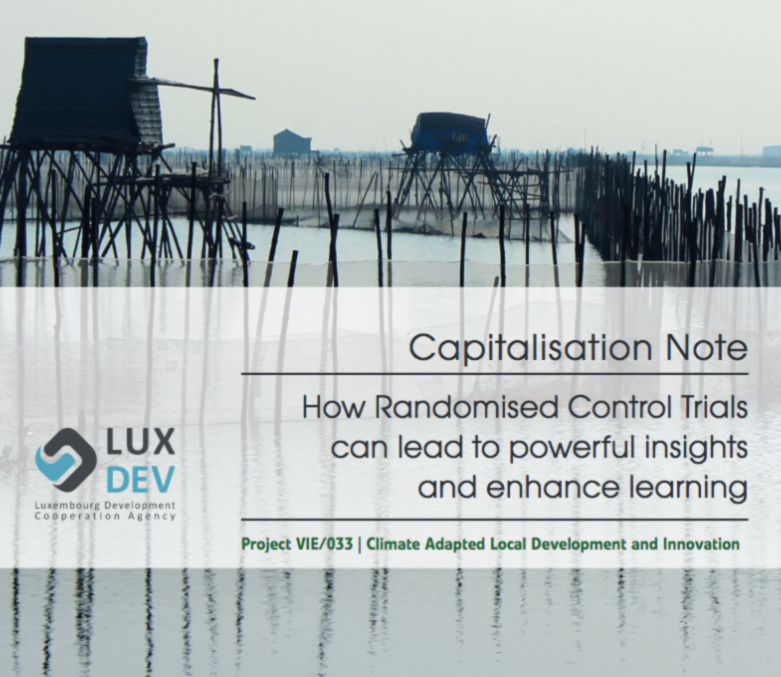
In 2013, LuxDev launched the Climate Adapted Local Development and Innovation Project (VIE/033), benefiting 29 poor and vulnerable communes in three districts of Thua Thien Hue province.
The project’s primary aim was to protect people’s livelihoods and strengthen their resilience within a context of increasing climate shocks and stresses, including more frequent typhoons, more severe floods in the rainy season, droughts in the dry season and a substantial loss of land to the ocean.
The Final Evaluation report found that by end 2017, the project had contributed to sustainable, equitable and efficient trends of poverty reduction and adaptation to climate change.
These achievements were attributed to project interventions with relative certainty, because the outcomes were measured based on the pre and post data collected by the project Monitoring and Evaluation system.
To further test and confirm its impact on target beneficiaries, the project also conducted the Randomised Control Trials study, to help establish whether the achieved outcomes were natural, or rather induced by the project’s many interventions.
This at a time when the team for the final evaluation was on the ground Typhoon Damrey, one of the worst storms to hit Vietnam in years, made landfall on 4 November 2017 with devastating consequences for the central provinces of Khanh Hoa, Phu Yen and Quang Nam, where people rely heavily on rice and fish farming.
At least 106 people have died and thousands of houses have been damaged.
It was the worst storm on record since 2001.This exceptional situation of a natural disaster in the project area made it possible to compare the resilience of assisted households to non-beneficiaries.
The Randomised Control Trials are a technical evaluation that allows estimating the impact achieved by the project intervention. The validity of the estimate stems from a comparison of the beneficiaries (Treatment Group) to non-beneficiaries (Comparison Group) at the beginning as well as end of the project.
Read our capitalisation note about the Randomised Control Trials
A new climate cooperation between Luxembourg and Vietnam
On Monday 18 June 2018, Hue City celebrated the closing of the 5-year ODA-funded ‘Climate Adapted Local Development and Innovation Project’ (VIE/033), and in the same event launched the very first two projects funded by the Luxembourg Climate and Energy Fund to be implemented by LuxDev. These two new interventions are the ‘Energy Efficient Lighting NAMA pilot in Hue City’ (VIE/401) and the project ‘Climate Adaptation and Resilience in TT Hue Province’ (VIE/433).
The event brought together high-level delegates from the Ministry of Planning and Investment, Thua Thien Hue (TT Hue) Provincial People’s Committee (PPC) and relevant departments, the Luxembourg Embassy in Laos, LuxDev HQ and regional office in Vientiane, VIE/033 project partners and staff from the project’s target districts, some community representatives and beneficiaries, as well as some old ‘Friends of the Project’.
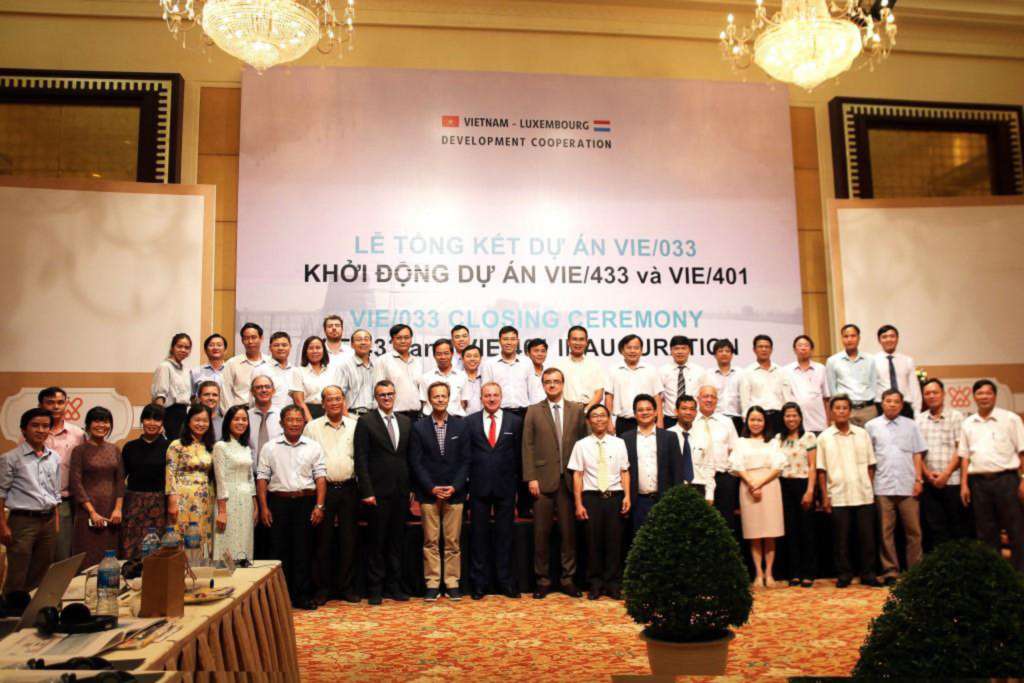 Group photo
Group photoMr Nguyen Van Phuong, Vice-Chairman of TT Hue PPC, and Mr Claude Jentgen, Chargé d’Affaires at the Luxembourg Embassy in Laos, both highlighted and appreciated the long-standing and strong diplomatic relations between the two countries, with the 45th anniversary of these relations having been celebrated in Hanoi just days ago. Mr Jentgen remarked that Luxembourg is the fifth biggest European Union investor in Vietnam, and further reiterated that whereas its Official Development Assistance (ODA) is phasing out with Vietnam having reached middle-income status, new opportunities arise to transform the long-standing partnership into climate cooperation.
Dr Alain Jacquemin, VIE/033 Chief Technical Coordinator, presented the overall results of the project, measured through a set of 27 quantitative indicators. Out of these, 23 met or exceeded their End of Project (EOP) target – including six exceeding that target by 20-50%, and five by more than 50%. Four indicators did not meet their target. Further, data from a Randomised Control Trial in communes outside of the project target area and collected through baseline and endline surveys, gave more evidence and valuable insights on the real impact of project interventions in target areas versus non-project areas, reflecting major differences on household incomes and poverty reduction rates, as well as on the coping capacity of communities and households to respond to climate impacts.
Dr Adam McCarty, Team Leader of the project final evaluation and earlier also the Mid Term Review, called VIE/033 “an extraordinary success” referring to its key results, both quantitative and qualitative, as observed first-hand in the field and measured through the project’s elaborate monitoring system. He highlighted and appreciated the fact that the project did not just focus on its many successes, but also took the initiative to study and investigate activities that didn’t go as planned, rather than ignoring them, thus turning them into ‘lessons learned’ for future interventions.
Subsequently, the audience listened to a brief account by one of the district leaders, and to three testimonials from project beneficiaries. This was followed by the formal launch of the Project Compendium, a document that gives a fairly detailed account of overall project results achieved, and WHAT was done, WHY and HOW to come to those results.
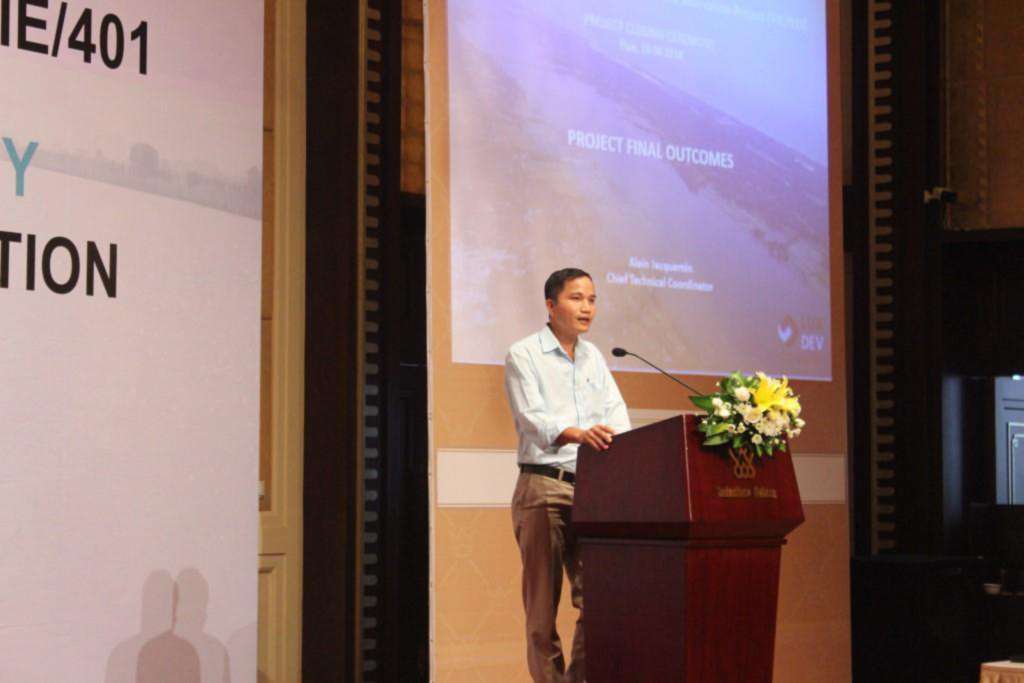 Mr Nguyễn Lương Trí from Quang Tho II Agriculture Cooperative, Quang Dien district
Mr Nguyễn Lương Trí from Quang Tho II Agriculture Cooperative, Quang Dien districtIn the second half of the meeting, with focus on the two new climate interventions in TT Hue, Dr Phong Tran of the Institute for Social and Environmental Transition–International (ISET-Viet Nam) sketched the context of climate change in Vietnam and Hue. He highlighted that Vietnam is one of the most vulnerable countries to the threats of climate change, mainly due to its densely populated and long coastline that is highly exposed to typhoons and sea level rise. “The sea level in Thua Thien Hue could rise by up to 94cm by 2 100 and this would continue to seriously affect the lives, incomes and health of local people, as well as the ecosystems and infrastructure systems of Hue City as they have done in the past”, he said.
The new chapter in the cooperation between Luxembourg and Vietnam was opened up by Mrs Dieschbourg, Luxembourg’s Minister for the Environment, who, through a 15-minute video message, pointed out that “this first bilateral climate cooperation can be instrumental for Vietnam to enhance its climate-finance readiness and be first-mover in terms of accounting, monitoring, reporting and verification of climate finance. In this sense, this little step will help to build international climate cooperation trust and practice. Luxembourg is at your side fighting climate change“.
Extract of the video speech by Mrs Dieschbourg, Luxembourg Minister for the EnvironmentSubsequently, Mr Nguyen Quang Cuong, Vice-Director of the provincial Department of Planning and Investment and Director of the Luxembourg Projects Management Board, briefly introduced the two new projects to the audience, and confirmed that both are in a position to bank upon the effective institutional structure, operational systems and implementation mechanisms that were put in place by VIE/033.
In his closing remarks, Mr Gaston Schwartz, Managing Director of LuxDev, once again highlighted the importance of monitoring and stated that “the methodology and the way that monitoring has been done in project VIE/033 should be an inspiration for LuxDev colleagues in other countries”.
Vietnam - Promoting community-based approaches in climate-adaptive and resilient infrastructure planning and implementation
One of the important intervention areas of the Luxembourg-funded Climate-adapted Local Development and Innovation VIE/033 project consisted of reinforcing and developing climate-adaptive and resilient physical infrastructure in target communes, through improving and/or protecting people’s livelihoods against various impacts of climate change such as floods, storms, the salinisation of land and lagoon water, dune and river erosion, etc.
Around 45% of the project budget was dedicated for small-scale infrastructure (INFRA) sub-projects and these are split into the following 8 categories: river dykes and embankments (e.g. to protect productive land), bridges and sluices (e.g. to prevent further salinisation of paddy fields), pump stations, irrigation and drainage canals, kindergarten classrooms with shelter function (e.g. to enable women to engage in productive activities), boat shelters (e.g. to protect fishing folk from damage to their main economic asset during typhoons), access roads to productive areas (usually with dyke or evacuation function), and water tanks.
 School children
School childrenThe interventions were proposed jointly by the community and local authority during annual project planning workshops, and were based on 5-year Socio-Economic Development Plans (SEDP) that resulted from the Local Participatory Planning Process (LPPP) and Community Vulnerability Capacity Assessment (CVCA) reports that had been developed at the start of the project.
Each district put forward a pre-selection of sub-projects to project management, which were then reviewed and evaluated against a set of social and economic criteria, in order to find out which proposal would add most value to the project’s mission of effectively improving and/or protecting people’s livelihoods.
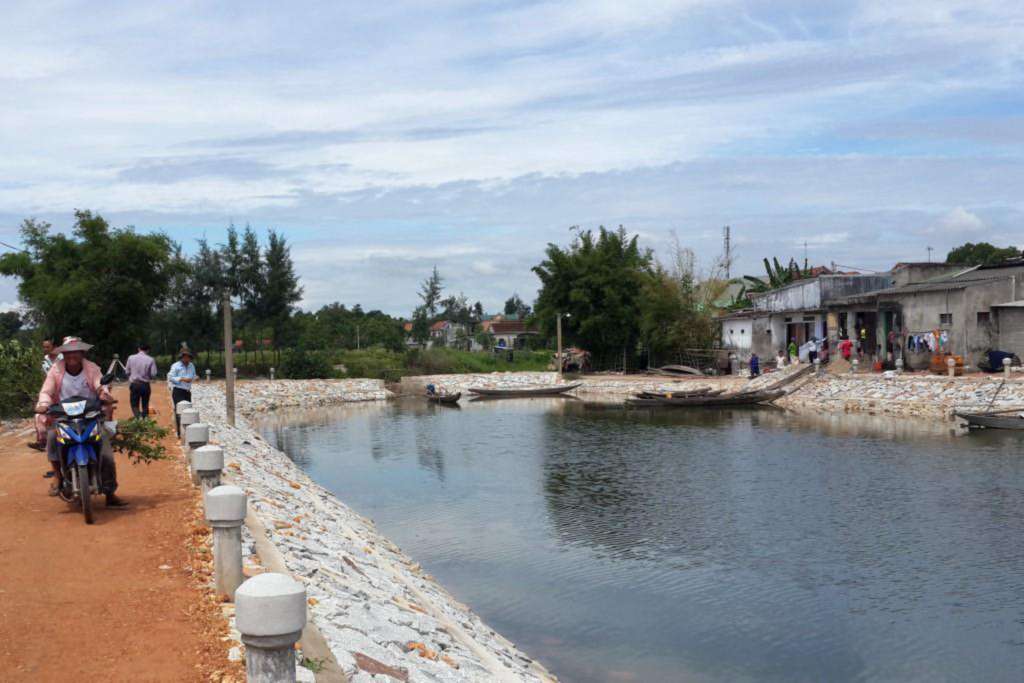 Le Binh boat shelter
Le Binh boat shelterIn order to assess the practical situation and technical aspects as well as their feasibility, project management, including the project’s Technical Adviser for Infrastructure, carried out field observations and assessments for each suggested sub-project, with the participation of commune authorities and community leaders. The proposed interventions were then ranked based on their scoring in field assessment reports that were prepared for each one of them, providing a clear picture of the cost-benefit analysis. Highest priority was contributed to poorest and most vulnerable villages, and resettlement areas were included in the list by default, due to their special nature and preferential focus in the project. Subsequently, field assessment reports were presented, assessed and discussed in detail in a meeting with relevant partners, and the final list selected based on available budgets. Selected INFRA sub-projects were then included in project annual work plans, and 78 such projects have been selected and implemented over the project’s four-year timeframe.
In line with the Paris Declaration on Aid Effectiveness aimed at increased government ownership and donor harmonisation and alignment, and its national translation in the Hanoi Core Statement, these sub-projects were, from the start of the project, carried out through delegation, whereby the district partner agencies were in charge of the budget, procurement and technical management, with support and supervision from the VIE/033 project team.
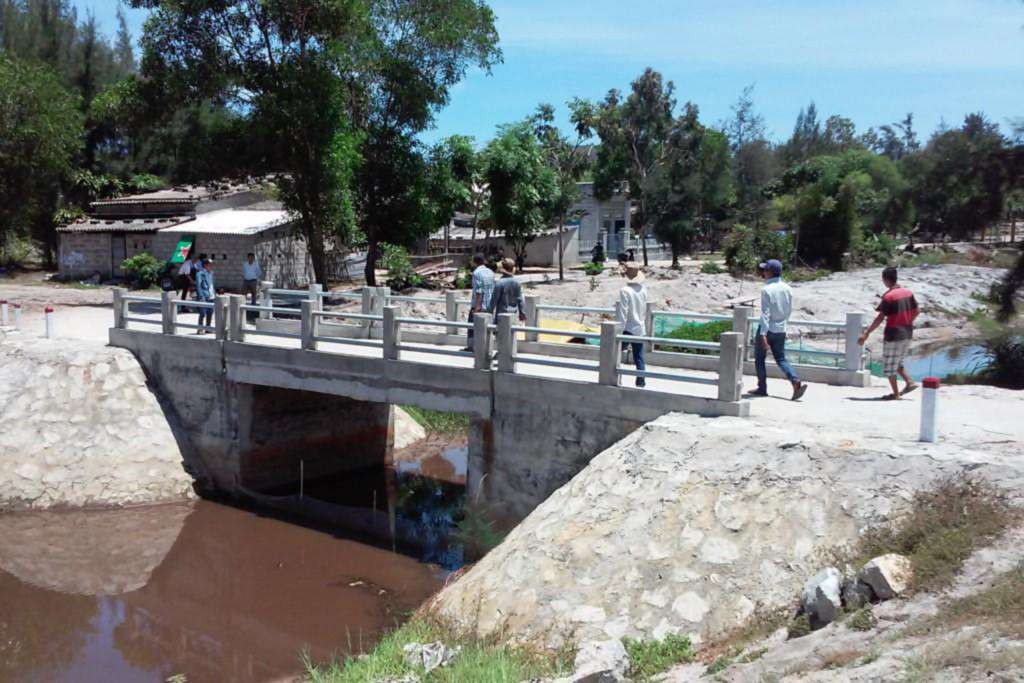 Nho bridge
Nho bridgeAs for outcomes, the 78 completed infrastructure interventions have had significant impact on the lives and livelihoods of people in target areas, especially those households suffering significant damage and loss caused by disasters. Over 30 000 households have had their livelihoods and resilience improved, and 5 653 hectares of productive land are now better protected against the impacts of climate change. Project M&E data indicate that 84% of the interventions were completed on time and were found to be resilient. Only three facilities required minor maintenance and two were in need of more serious repair following last November’s major flood. These findings are testimony of the high quality, praised by both technicians and beneficiaries, as well as of effective Operation, Maintenance and Management (OM&M) systems that were put in place, as consistently reported throughout project duration. As of end 2017, 98.6% of all sub-projects had sufficient OM&M measures in place, thus exceeding the initial target of 90%.
Local beneficiaries demonstrated a strong commitment and ownership toward the project’s infrastructure interventions. They were actively involved in the whole process -- from the initial needs identification and proposal of infrastructure sub-projects, to planning and financial contributions (usually a standard 2% of the total cost), to supervision during the construction phase and maintenance tasks after handover. Thua Thien Hue province is now considering wider application of this participatory approach in planning and implementing infrastructure projects.
Vietnam - Off-farm livelihood diversification support as a strategy to adapt to climate change
Livelihood options for poor and vulnerable women and men in lagoon and coastal areas of TT Hue province are by and large restricted to fishing, aquaculture and agriculture, and heavily dependent on natural resources. As the pressures on these resources are increasing inter alia due to changing climate conditions, and as rural employment opportunities are becoming increasingly scarce, local households face ever more risks, vulnerabilities and uncertainties.
On the other hand, TT Hue province is today home to six industrial zones and the demand for labour in various industries is relatively high. Therefore, aiming for increased economic diversification through off-farm salaried employment and self-employment opportunities, VIE/033 identified the need to support the provision of various vocational trainings to unemployed labourers in three target districts, allowing them to get access to up-to-date knowledge and develop the professional skills required by the local industries.
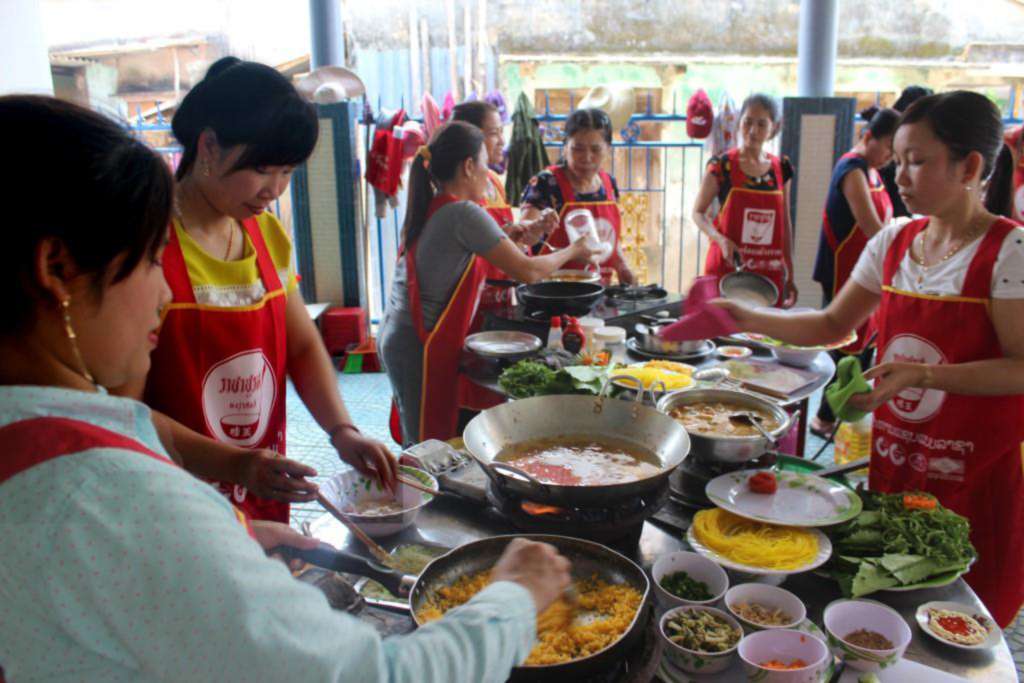 Disadvantaged women attending their last cooking class before final examination, Phu Loc district
Disadvantaged women attending their last cooking class before final examination, Phu Loc district Consequently, from 2014 to 2017, the project supported over 800 unemployed rural labourers in the project’s three target districts of Quang Dien, Phu Vang and Phu Loc, with trainings of various vocations that responded to the region’s labour demand, such as industrial sewing, cooking and food pairing, welding, engine mechanics, and electricity. These capacity building interventions aimed specifically at young people as well as disadvantaged women, the latter whom due to their more limited access to information and financial resources, tend to be more acutely affected by the various manifestations of climate change.
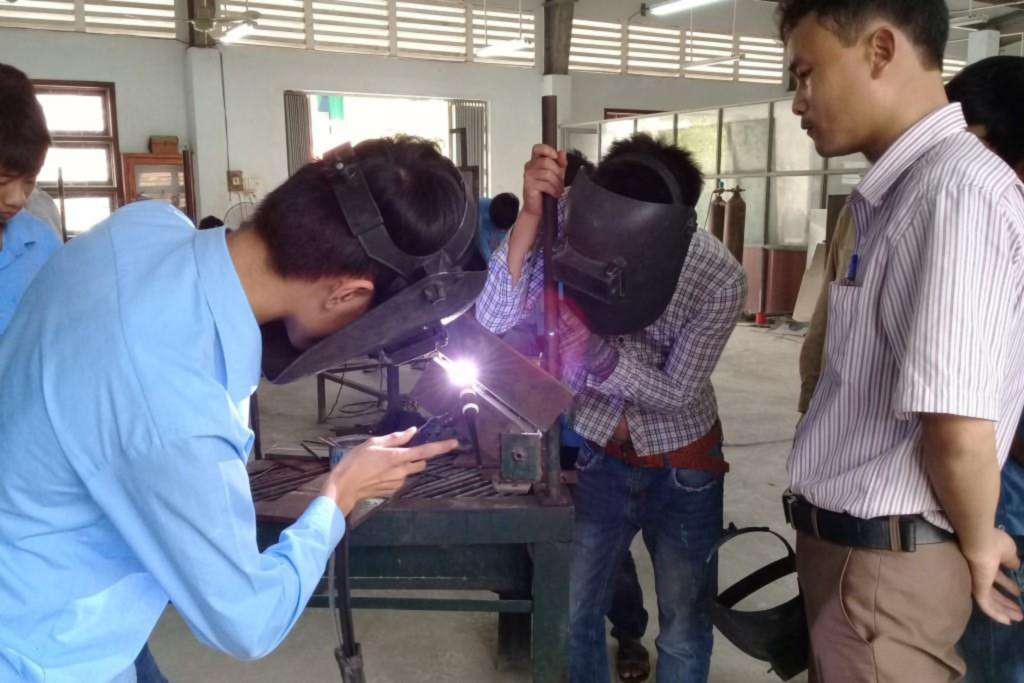 Young men supervised during welding vocational training, Quang Dien district
Young men supervised during welding vocational training, Quang Dien districtResults of a comprehensive job and income survey, recently conducted as part of the project regular monitoring and evaluation among a 65% sample (520 randomly selected beneficiaries), showed that 71% of all graduates are now fulltime employed, with an average monthly income of 3,611,843 Vietnam Dong (VND) (about US$160). Interestingly, 8.1% of those newly employed came from resettlement areas, at present still considered major pockets of poverty, and 7.6% were registered as ‘poor’ or ‘near poor’ as per the Government of Vietnam’s official poverty classification. Over 88% of newly employed graduates now earn more than the minimum monthly income of 2,100,000 VND/month as per governmental Decree No. 182/2013 that was in vogue at the start of the project, and more than half of all graduates earn more than the minimum wage as revised and applied from January 2018 (3,090,000 VND as per Decree No.141/2017).
 Supervisor demonstrating industrial sewing exercise to female trainees, Phu Vang district
Supervisor demonstrating industrial sewing exercise to female trainees, Phu Vang districtGraduates from the industrial sewing (80.3%) and cooking classes (62.7%) accounted for the highest contribution to this result, with the large majority of their graduates now having fulltime contracts in the garment industry and tourism sector, both growth industries of regional and national significance.
These outcomes demonstrate that expanding the scope for off-farm income generating activities allows rural households to decrease their dependency on natural resources and diversify their economic opportunities, and contributes to people’s increased resilience to the effects of climate change.
Vietnam – Strengthening Community-Based Organisations (CBOs) for the co-management and protection of lagoon natural resources
One major focus area of the Climate-Adapted Local Development and Innovation Project (VIE/033) is the conservation of the 22,000 hectare Tam Giang-Cau Hai lagoon, as a vital source of food and livelihoods for local people, as well as a potentially important economic asset for lagoon-based ecotourism in Thua Thien (TT) Hue province.
In the past, the area was ruled by an open access fishery regime, based on the common saying “Điền tư, ngư chung” or “Farm land is private, but water area is open”. Local people competed for resources without taking adequate responsibility for protection. Issues of over-exploitation and illegal fishing rose and led to the degradation of lagoon resources, thus threatening the livelihoods of thousands of households, and inviting community conflicts.
 Chairman and other members of a Fishing Association at the patrol boat handover ceremony in Loc Tri commune in October 2016, Phu Loc district
Chairman and other members of a Fishing Association at the patrol boat handover ceremony in Loc Tri commune in October 2016, Phu Loc districtAligned with the Vietnamese Government’s policies and programmes for decentralisation, introduced in 2003, VIE/033 supported community-based Fishery Associations (FAs) and relevant local government agencies to establish an efficient co-management model for the lagoon. Through Delegation Agreements signed with these agencies, and with technical and budget support from LuxDev, the counterpart was in the lead to implement a sizeable multi-year programme consisting of various activities.
The overall focus of the interventions was on strengthening the organisational and management capacity of FAs, and on raising the environmental awareness and increasing the knowledge and technical know-how of their members, the community and the local leadership, in order to look after the lagoon for the common good.
Specific project activities focused on the participatory formulation of local fishing regulations, the expansion of community-managed Fishery Conservation Zones (FCZs), capacity development in environmentally-friendly fishing practices, the protection of spawning grounds, and the establishment of patrol teams within FAs to monitor regulations and practices. As such, the project for example supported demarcation poles, sign boards and fish aggregating devices to define the boundaries of the extended FCZs, which were stocked with various fish and crustacean species in order to improve the biodiversity and proliferation of adaptive species. Communities and authorities were also equipped with tools such as patrol boats and water quality testing equipment, to enable their supervision and monitoring tasks.
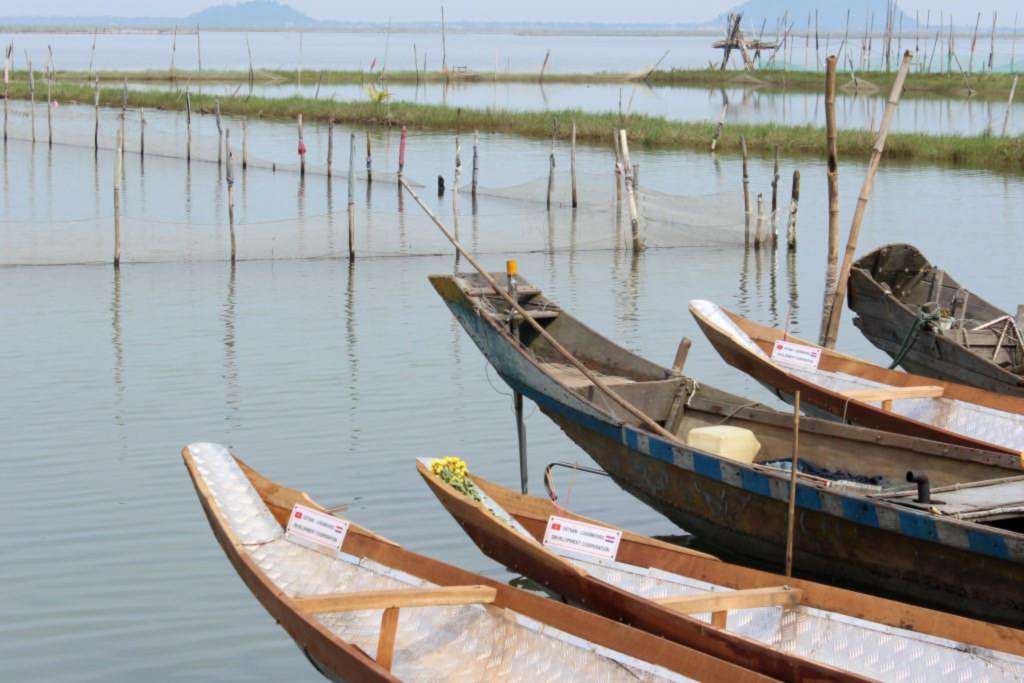 Project-supported patrol boats were handed over to Fishing Associations to supervise fishing activities in the lagoon area, Loc Tri commune, Phu Loc district
Project-supported patrol boats were handed over to Fishing Associations to supervise fishing activities in the lagoon area, Loc Tri commune, Phu Loc districtIn September 2016, with project support TT Hue province issued a decree formally adopting local regulations for fishery exploitation and management to be applied in the whole lagoon area. Further, in November 2017, based inter alia on the experience with the FAs in TT Hue, the National Assembly adopted the revised Law on Fisheries, including a new article that allows the co-management of natural resources.
As for the outcomes -- 13 Fishery Associations had been established and/or strengthened and were granted the rights for fishing and co-management, and their capacity to do so markedly improved. The area earmarked by the government as Fishery Conservation Zone increased from 316 ha in 2014 to 567 ha in late 2017, surpassing the project’s initial target of a 50% expansion by project end.
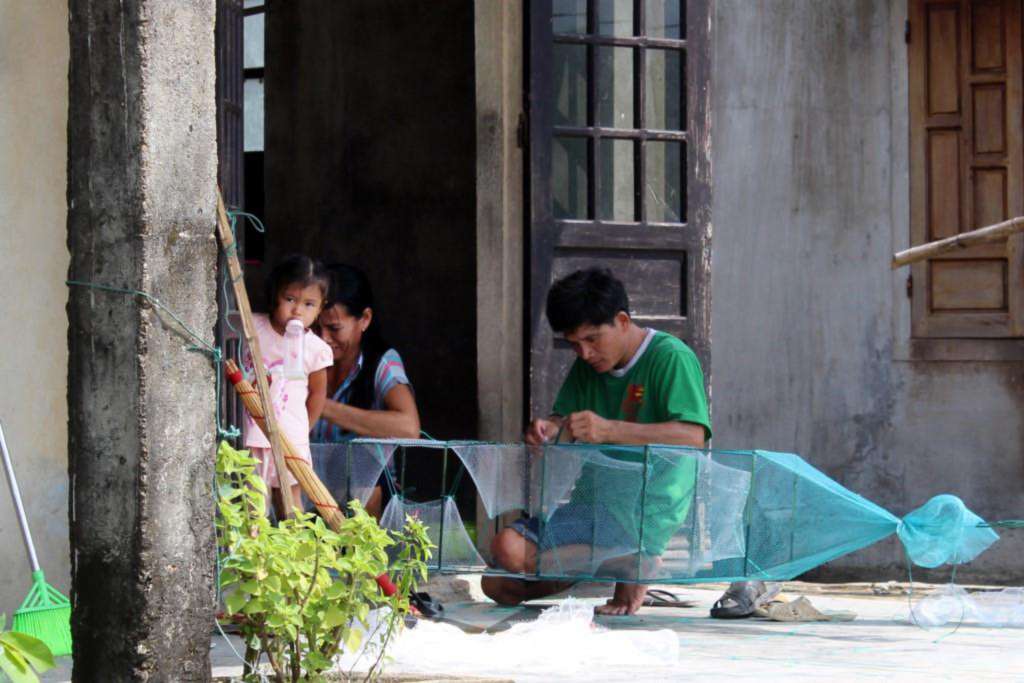 Husband and wife cleaning and fixing their fishing net in Le Thai Thien resettlement area, Loc Tri commune, Phu Loc district
Husband and wife cleaning and fixing their fishing net in Le Thai Thien resettlement area, Loc Tri commune, Phu Loc districtFA members also noticed considerable change in the attitude of local people towards the management of aquatic resources. Said Mr Le Thanh Nam, Chairman of the newly established Hai Phu FA in Phu Loc district: “CBOs such as FAs need the recognition and support of the authorities. Now we have a solid ground which has led to more mutual support and solidarity within the fishing community as well as towards the lagoon and environment we live in”. The behavioural change and increasing respect for rules and boundaries by local households is also reflected in the data generated by the project’s monitoring system, e.g. the decrease in illegal fishing practices, the restoration of the ecosystem, or the measurable improvement in the quality of the lagoon water.
The above positive outcomes further highlight the importance to support Community-Based Organisations (CBOs) such as Fishing Associations in order to effectively adapt to climate change. They are a major partner of the Government in the protection and management of aquatic resources and play a crucial role in the implementation of community-based activities, thus contributing directly to delivering more secure livelihoods and a safe living environment for future generations.
Vietnam - Effective use of participatory methods for climate-adapted local planning in Thua Thien Hue
A major objective of the Climate-Adapted Local Development and Innovation Project, VIE/033 was to promote democracy and community ownership by enabling communities in Vietnam’s Thua Thien Hue province to become not only the active partners in local development, but also its engines. During inception and implementation phases this bold objective justified the project’s strong focus on community mobilisation, participation and ownership, considered critical for delivery, impact and long-term sustainability. Thus, the Project implemented a range of activities aimed at increasing local capacities and capabilities of communities and government staff in support of improved local governance.
Two interventions in particular were considered very important for the development and application of participatory methods for climate-adapted local planning: Commune Vulnerability and Capacity Assessments (CVCA) and the Local Participatory Planning Process (LPPP).
Commune Vulnerability and Capacity Assessments (CVCA) reports were developed for all 29 project target communes with the active participation of communities, mass organisations and local government staff, in line with the national and provincial policies and plans on Climate Change Adaptation (CCA), Disaster Risk Reduction (DRR) and Inter-Coastal Zone Management. Considering the context of Thua Thien Hue province, where the impact of climate change on the coastal and lagoon environment and people’s livelihoods is quite dramatic, such CVCA reports are an essential tool for planners to understand and assess current situations, and design effective interventions for capacity building and infrastructure development in support of innovation, risk mitigation and adaptation of livelihoods.
CVCA reports were subsequently used as important building blocks during four-day planning sessions with communities in all target villages as part of the Local Participatory Planning Process (LPPP). 224 Village Development Plans were prepared for each target village by a total of 8,355 household representatives. These were then inserted into Commune Development Plans and further integrated into the government’s Five-Year Socio-Economic Development Plans 2016-2020.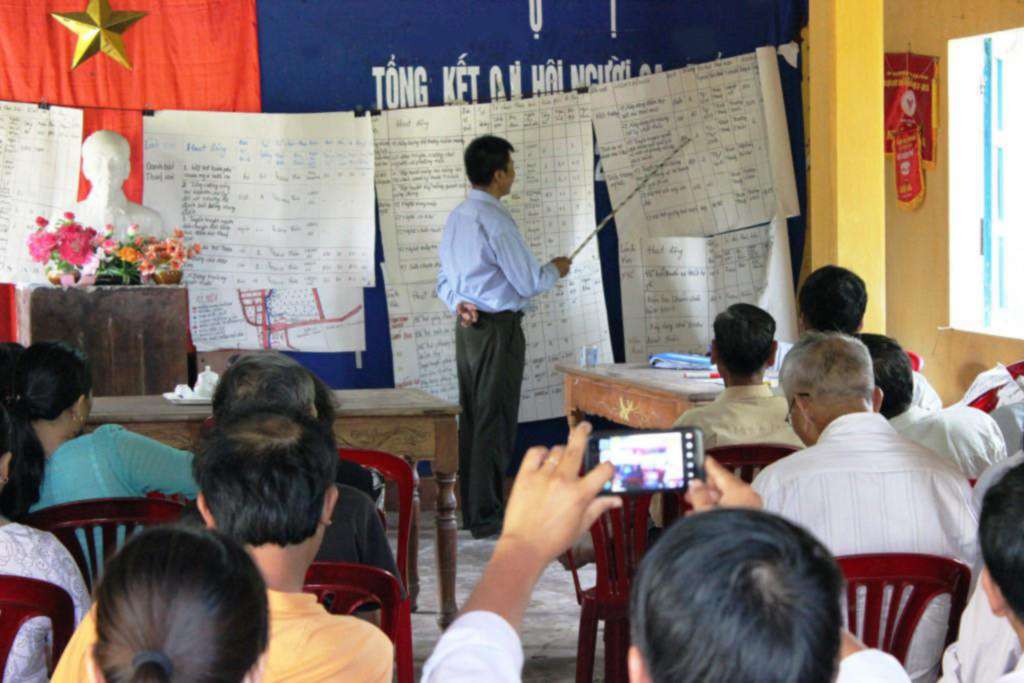
A participatory planning manual developed under a previous Luxembourg-funded project was substantially revised and updated, with integration of new components such as Change Adaptation (CCA), Disaster Risk Reduction (DRR), environmental protection, gender equality and women’s economic empowerment, as well as market development for agricultural production and services. Government staff at all levels was trained and developed the capacity to use these tools and implement the process.
Commune Vulnerability and Capacity Assessments (CVCA) reports and the Local Participatory Planning Process (LPPP) output were not only used by project stakeholders for annual project planning, but they also became key building blocks for the development of plans under a number of national target programmes, such as a Poverty Reduction Programme for 257 Coastal Communes and the New Rural Development Programme master plans. They are major priorities in the government’s aim for further decentralisation down to the commune level, and with increased community participation.
The process and outputs of the LPPP proved to be major improvements comparing to earlier planning approaches. This was made possible thanks to the training of 32 master trainers and over 700 commune and village staff, as well as a province-wide rollout of the LPPP on-going as from 2016, funded and implemented with government resources.
CVCA and LPPP have demonstrated to be very effective methods for participatory planning in climate-vulnerable localities and communities. They have contributed to a better understanding of key issues, and have led to increased empowerment and ownership of the planning cycle and use of community resources, resulting in ameliorated effectiveness and sustainability of interventions. They have also contributed to a enrich the partnership between villagers and relevant authorities, and have become an essential work element for improved local governance.
As stated in the independent Mid-Term Review from early 2016, VIE/033 Project drives to “sustained institutional changes” and CVCA and LPPP outputs are “enhanced (and notably more participatory) versions of the established 5-year and annual planning processes in Vietnam”.
Vietnam - Tam Giang-Cau Hai Lagoon’s Untapped Potential for Community-Based Ecotourism
With a 128 km coastline and its 22 000 ha Tam Giang-Cau Hai Lagoon, Vietnam’s central province of Thua Thien Hue (TT Hue) is frequently exposed to natural hazards and increasingly facing environmental impact and damage. At the same time, however, the unique environment of this largest lagoon system in Southeast Asia, and the scenic beauty of its surroundings, have the potential to develop a community-based ecotourism (CBET) sector and significantly contribute to strengthening people’s livelihoods, and increasing their economic resilience to climate change.
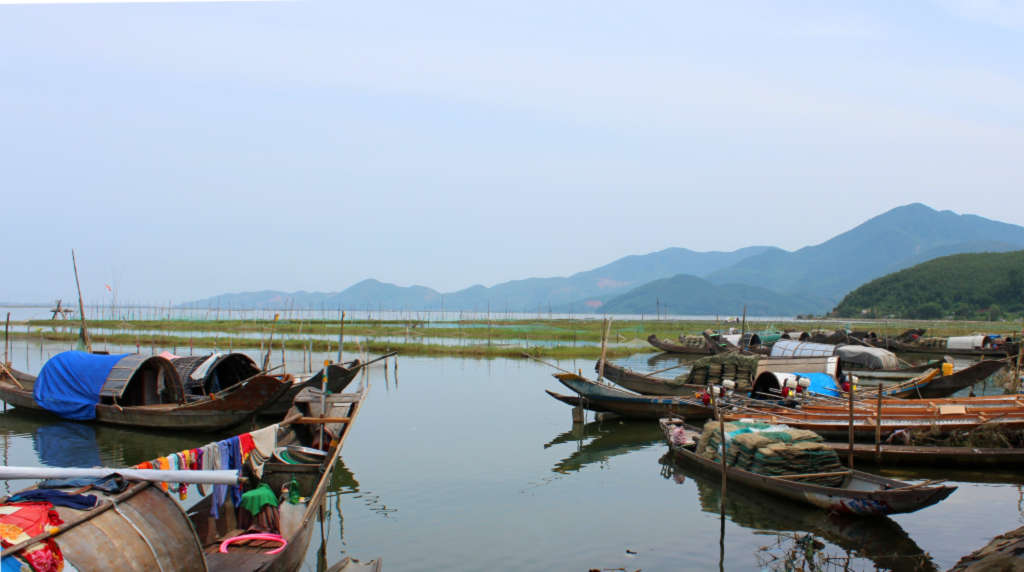
Figure 1 - View of Tam Giang Cau Hai lagoon from a fishing village in Phu Loc district, Thuan Thien Hue
Whereas national policies and strategies for tourism development are in place, and TT Hue developed a “Socio-Economic Development Plan for the Tam Giang-Cau Hai Lagoon up to 2020”, the province has faced challenges to get CBET off the ground. On the demand side, due to lack of marketing and promotion, the lagoon remains largely unknown to the many tourists that are visiting Hue City, the former imperial capital of Vietnam. On the supply side, local people are not familiar with the concept of community-based tourism, lack the necessary skills and technical support, and do not have the funding for investments in upgrading community and homestay facilities.
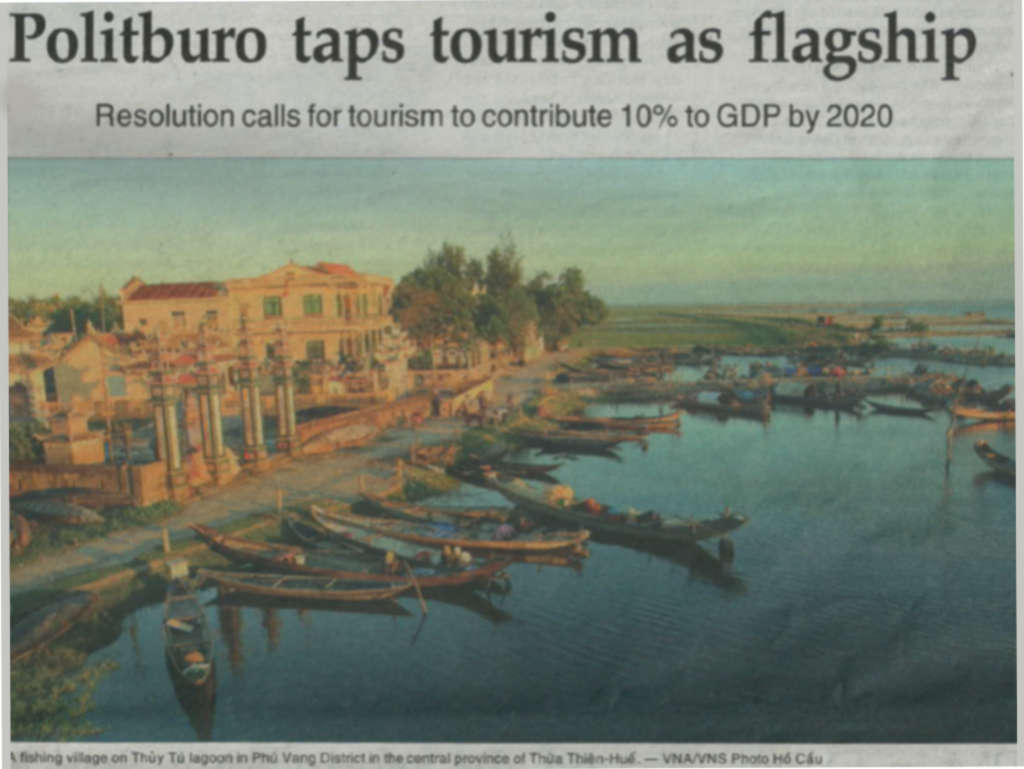
Figure 2 - Picture of TT Hue's lagoon on cover page of Vietnam's main English language newspaper (20/01/2017) as part of an article on tourism potential.
Recognising the uniqueness and potential of the lagoon, and with its focus on climate change adaptation and local development, project VIE/033 started working with communities, civil society, local government and the private sector to establish a number of CBET models, one in each of the three project districts. The aim of these models is to demonstrate how CBET can contribute to economic growth, while at the same time, through community mobilisation, ownership and management of natural resources, also help protect the fragile environment.
As one of the first steps, the project organised a few exposure visits. First, to a number of International Labour office (ILO) and UNESCO supported community-based models in neighbouring Quang Nam province, subsequently to Inle Lake in Myanmar, where a very similar environment attracts some 200 000 tourists a year. The latter trip was supported by LuxDev’s MYA/001 tourism project. All leaders from the government provincial and district tourism departments in TT Hue and specialists of the Department of Planning and Investment participated, along with representatives of civil society and the private sector.
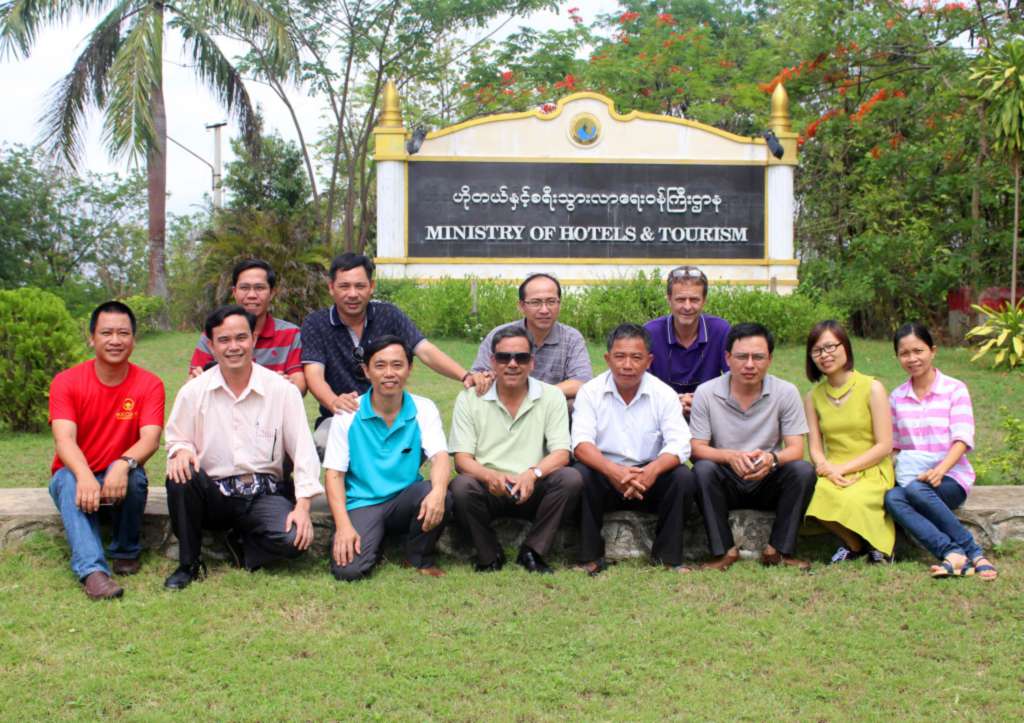 Figure 3 – VIE/033 Myanmar exposure visit participants at the Ministry of Hotels and Tourism in Naypyitaw
Figure 3 – VIE/033 Myanmar exposure visit participants at the Ministry of Hotels and Tourism in Naypyitaw Following these learning experiences, detailed plans for three pilot models were jointly developed, and a first two-day training on CBET provided by TT Hue’s Tourism College took place in Hue City with representatives of provincial, district and commune level as well as 27 village leaders. The training generally aimed at enhancing the awareness and knowledge of CBET destination management, and at strengthening community capacities for planning, management and tourism services in the three pilot communes of Quang Ngan, Phu An and Loc Binh. During the event, local regulations on CBET operations were jointly defined.
An interesting feature of the CBET pilots is the Public-Private Partnership (PPP) setup, with the private sector stepping in as co-facilitator and specialised partner, to support local communities in organising things on the supply side, while at the same time help promote lagoon eco-tourism and create a demand for the services and programmes on offer. A 20-year business plan, with clear agreements and responsibilities was signed between a local cooperative as the leading civil society partner and a Hue-based tour agent. The cooperation between these two partners, and implementation of their business plan, is supported by the three district Divisions of Culture, Information and Tourism, with whom LuxDev has signed Delegation Agreements, and as such are in the lead for implementation.
This close cooperation between project, local government, the private sector and cooperatives enables communities in lagoon-based villages in TT Hue to offer visitors a special and authentic cultural experience, and creates opportunities to tap into the growing domestic tourism market and since the recent opening of the ASEAN the regional tourism potential as well.
Vietnam - LuxDev project joins hands with United Nations ORANGE Campaign
From 25 November through 10 December, Human Rights Day, the 16 Days of Activism against Gender-Based Violence aim to raise public awareness and mobilizing people everywhere to bring about change.

Starting November 25, UN Women promotes the global 16-day ORANGE campaign, which aims to put this violence against women and girls in the spotlight, through many different actions and interventions by governments, civil society organisations, private businesses and individuals worldwide.
Studies and statistics demonstrate that such action is also necessary in Vietnam, where a study found out, that one in three women are beaten or sexually abused by their husbands or partners. If emotional abuse is added, the figure goes up to six out of ten. Further, a recent small-scale survey conducted in Hanoi and Ho Chi Minh City found that 87% of women and girls interviewed had experienced some form of sexual harassment in public places.
As a local development project in TT Hue province, VIE/033 takes a strong focus on women. Indeed, in spite of the overall achievements in socio-economic development, poverty remains a fact of life for many people and women are over-represented. Furthermore, many women who are not officially categorised as ‘poor’ or ‘near-poor’, are most vulnerable and at risk of falling into poverty quickly from the moment something goes wrong – for example as a result of a climate or weather-related event, to which the province is prone to.
The project, therefore, supports and works closely with the Women’s Union, specifically on the broad issues of Gender Equality and Women’s Economic Empowerment. As part of that support, we decided to jointly engage in the global campaign as well as "Orange Hue City".
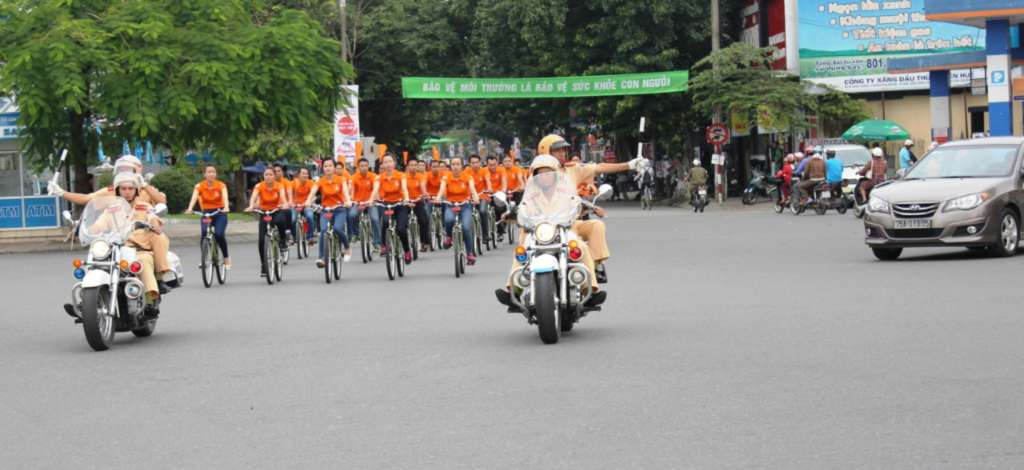
The main event of this 16-day campaign took place on Campaign Day, in the morning of 5 December, at TT Hue’s main cultural centre, with music and dance performances, speeches by provincial leaders, the UN Women Country Representative and Lux-Development. They were joined by a campaign team of 500 enthusiasts – every single one of them dressed in the colour of the day.

Thousands of leaflets were distributed at key places around the city, and an Orange parade on bicycles rode the city’s streets, which had been decorated in the colours of the 16-day campaign and brought the Campaign Day to an impressive close.

As the UN Women’s Country Representative stated in her speech: “fear of violence leads women to withdraw from society and from jobs, and causes girls to drop out of school”. Through this Orange campaign, and the wide media coverage in newspapers and on TV, people’s awareness about the forms and level of violence against women and girls, and what action can be taken against it, has been raised. In combination with the active support of the local authorities to tackle the issues, we are hopeful that it will contribute to a safer environment for women and girls and foster their socio-economic prospects.

Vietnam - Dyke upgrade in Phu Loc District brings peace of mind to 1700 households
Bau Duoc dyke has a direct impact on the agricultural production as well as transportation efficiency and safety for nearly 2 000 people in Loc An commune. Whereas the dyke functions as a protective levee against flooding of around 250 hectares of paddy field it also serves as a key means for farmers to transport their produce during the harvest season. The dyke will also take local populations from Chau Thanh village to the centre of the commune.
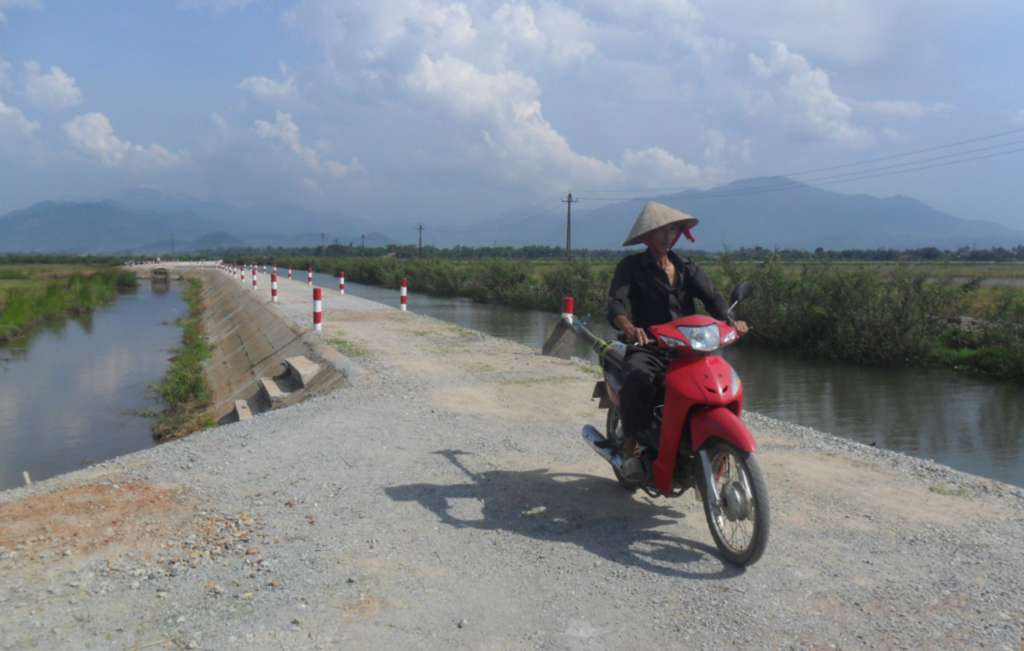
Prior to the renovation, being a low-lying and vulnerable earthen embankment with small crest, the dyke would get severely damaged by floods every year. As such, it did not do much to protect people’s livelihoods, and making use of the dyke for transportation purposes would at times be cumbersome, and dangerous as well.

With financial support of the Luxembourg Development Cooperation, Bau Duoc dyke was upgraded and put into operation in May 2015. The dyke base of 921m was enlarged and reinforced, the slopes of the embankment protected with concrete slabs, the surface macadamized and three drainage culverts were added to regulate water levels. Further, an access road of 450m was built to connect the dyke with other in-field roads as well as residential areas.
“The new dyke is very effective and helpful for farmers as it now protects 250 hectares of two-crop rice fields cultivated by around 1 700 households from being inundated during the summer and early-year floods”, says Mr Hoang Thi, Vice-Director of Dai Thanh Agricultural Cooperative. “In addition, it helps local farmers save a lot of money, to the tune of 210 million Vietnam dong (over 8 000 EUR) every year, which they would otherwise have to spend on repairing the annual damage to the embankment. Farmers of the four Agricultural Cooperatives of Dai Thanh, Tien Loc, Hai Ha and Chau Thanh are currently using the dyke to visit their rice fields and transport their agricultural produce, as well as for other daily activities”. Mr Thi further stressed the important role the upgraded dyke plays for people’s safety, as “the dyke reduces the risk for 116 households in Chau Thanh village, who are no longer isolated and can be easily evacuated to a safety shelter in the commune centre during heavy floods or typhoons”.
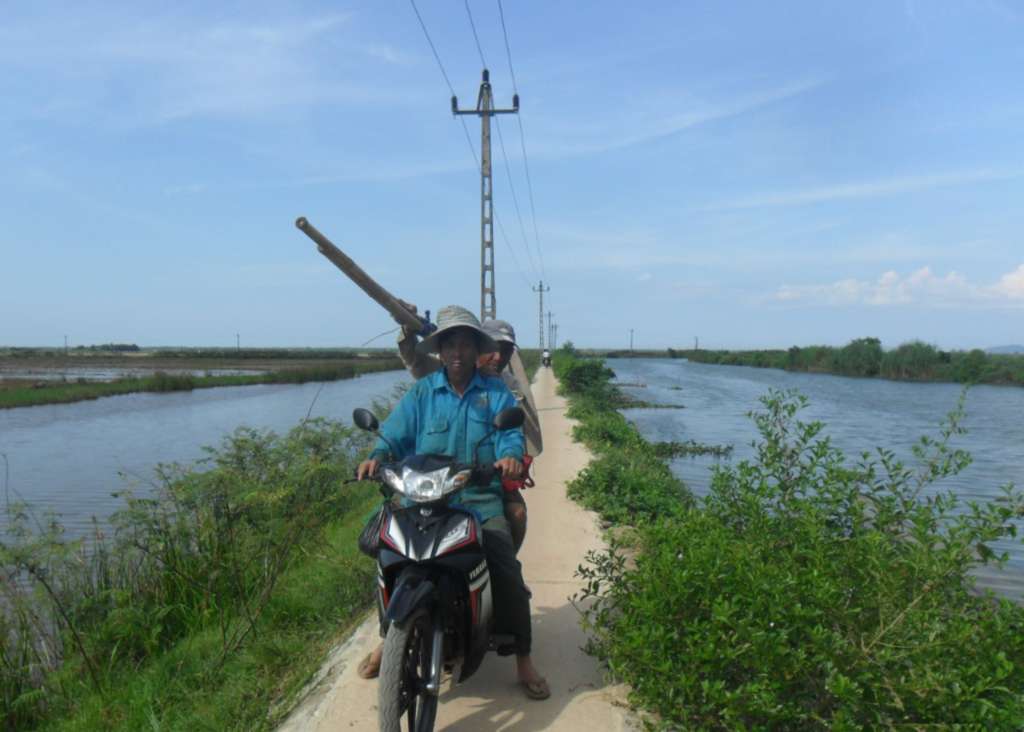
Many of the interviewed local farmers said that the newly upgraded dyke of Bau Duoc would have a positive impact on their production. Mr Nguyen Xuan Hoa, who owns 2 500m2 of paddy field and is a member of Dai Thanh Agricultural Cooperative says: “Since the dyke was put into service nearly three months ago, and due to the time we save on going back and forth to our fields, my family and I have been able to increase the time and frequency of visiting and tending to our fields. We strongly believe this will increase our rice production”.
Mrs Nguyen Thi A’s son nearly died from drowning during last year’s floods. Herself a rice farmer, she stated “It is now very convenient and safe for us to go to the local market and for my children to go to school by themselves on the newly upgraded dyke road. It gives me more time to work on knitting fishing nets which earns us additional income for the family”. Besides safety and peace of mind for her family, she mentions a social benefit that came with the new dyke: “Previously, I was unable to attend the evening events organised in the commune centre because of the dangerous road after sunset. Things have changed now and I can safely attend community and Women’s Union meetings”.
The upgraded Bau Duoc dyke has significant direct economic and social benefits for farmers and residents alike. It not only contributes to higher yields, but also protects families and their livelihoods from the increasing frequency and severity of climate change impacts.
Construction or upgrading of dyke roads is one of many types of infrastructure interventions under project VIE/033. Six such dyke roads were built in the project’s three target districts over the last 18 months, to the benefit of more than 2 800 households (ca. 14 000 people) and for the protection of 549 hectares of agricultural land.

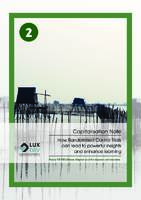

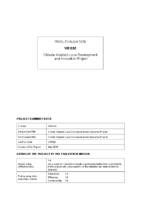
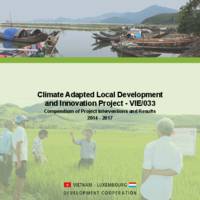
.VN__thumb.jpeg)
